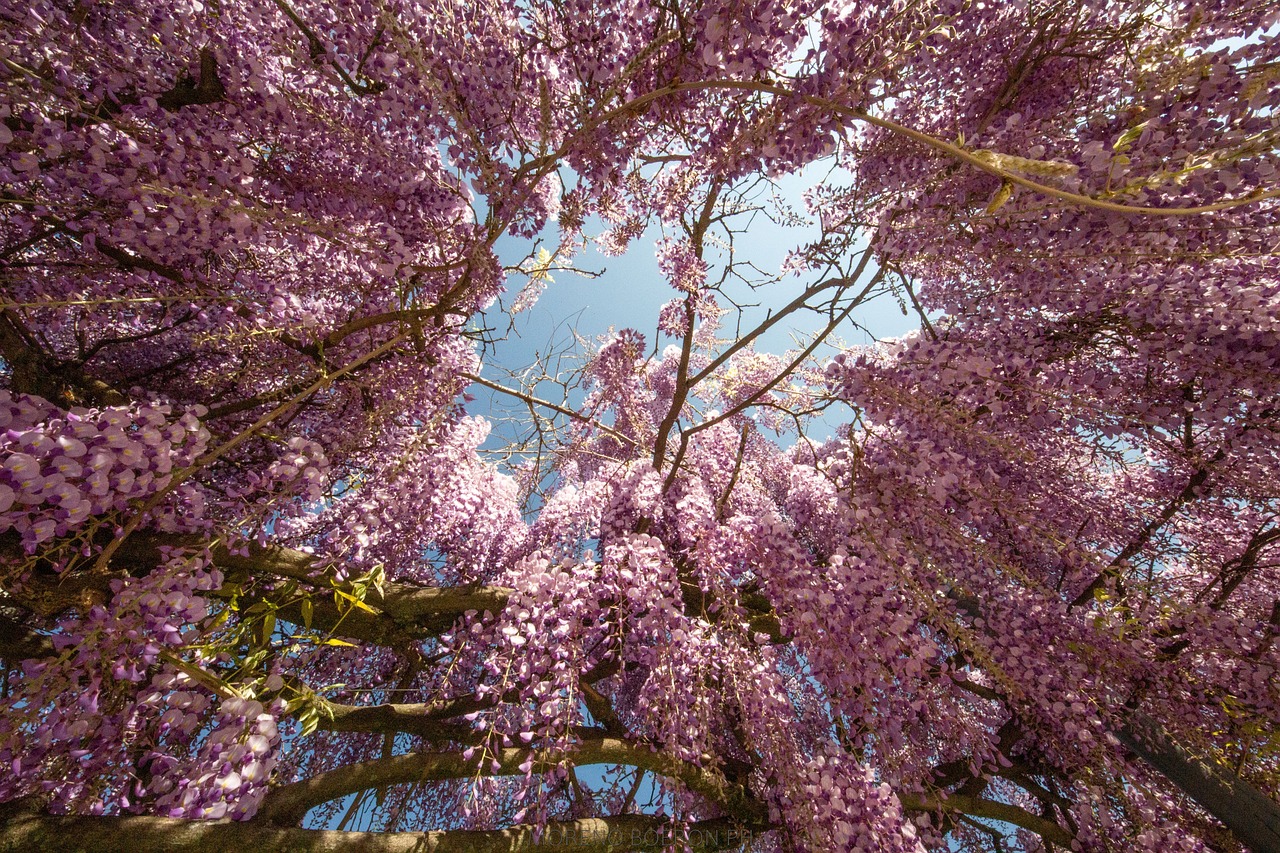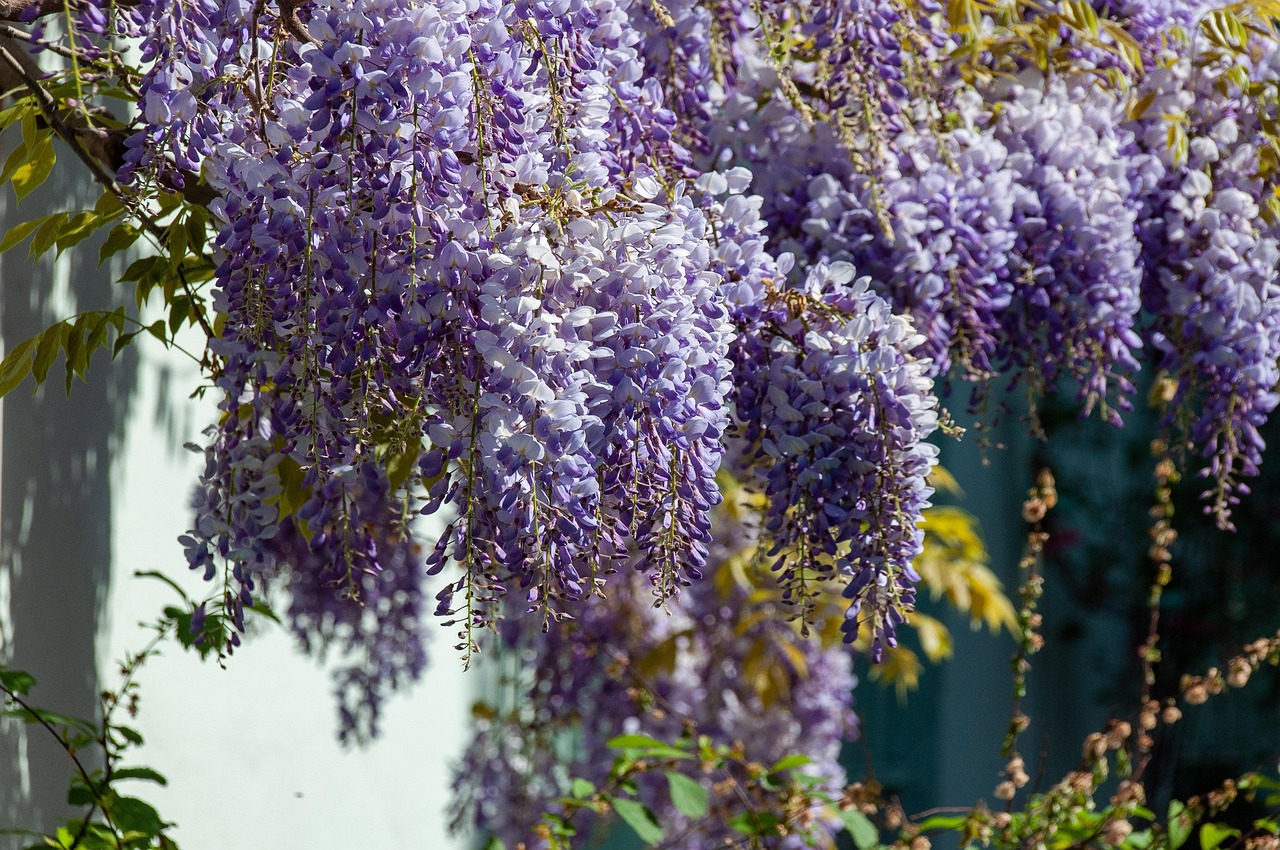Wisteria trees typically exhibit a fast growth rate, often reaching heights of 10 to 30 feet within a few years under optimal conditions. They thrive in well-drained soil and full sun, which promote vigorous growth and abundant cascading flowers. Regular pruning encourages flowering and maintains shape, enhancing their ornamental appeal in gardens and landscapes.
The growth rate of wisteria trees varies based on species and growing conditions, but on average, they can grow 10 to 15 feet per year. This rapid growth contributes to their ability to produce cascading flowers, making them popular in gardens.
Understanding Wisteria Trees
Wisteria trees are renowned for their stunning, fragrant blooms that create a breathtaking spectacle in gardens and landscapes. Known for their cascading clusters of flowers, these trees belong to the Fabaceae family. They are native to Asia and North America, with several species including the popular Japanese wisteria (Wisteria floribunda) and Chinese wisteria (Wisteria sinensis).

These trees are often used as decorative elements in residential gardens, parks, and public spaces. Their vigorous growth and charming flowers make them a favorite among gardeners and landscape designers. However, understanding their growth rate is crucial for proper care and maintenance.
Factors Influencing Growth Rate
The growth rate of wisteria trees can be influenced by several factors, including:
- Species: Different species of wisteria have varying growth rates. For instance, the Japanese wisteria tends to grow faster than the American variety.
- Soil Quality: Nutrient-rich soil promotes healthy growth. Well-drained soil with a good balance of pH is ideal.
- Climate: Wisteria thrives in warm climates and can be stunted by extreme cold or frost.
- Watering: Adequate watering during the growing season is essential. However, overwatering can lead to root rot.
- Pruning: Regular pruning encourages more vigorous growth and flowering. It also helps shape the tree and prevents overcrowding.
Growth Rates by Species
Here is a comparison of the average growth rates for some popular wisteria species:

| Species | Average Growth Rate (Feet per Year) | Blooming Period |
|---|---|---|
| Japanese Wisteria (Wisteria floribunda) | 10 – 15 | Spring to Early Summer |
| Chinese Wisteria (Wisteria sinensis) | 10 – 30 | Spring |
| American Wisteria (Wisteria frutescens) | 5 – 10 | Late Spring to Early Summer |
| Kentucky Wisteria (Wisteria macrostachya) | 6 – 12 | Late Spring to Early Summer |
Ideal Conditions for Growth
To maximize the growth rate of wisteria trees, certain conditions should be met. These include:
- Siting: Plant wisteria in a location that receives full sun for at least six hours a day.
- Soil Preparation: Amend the soil with compost or well-rotted manure to improve fertility.
- Support Structures: Providing a strong trellis or support will encourage upward growth and promote flowering.
- Pest Management: Keep an eye out for pests such as aphids and scale insects that can hinder growth.
- Disease Prevention: Ensure good air circulation to prevent fungal diseases that can affect the roots and foliage.
By understanding the growth rate of wisteria trees and the factors influencing it, gardeners can create optimal conditions for these beautiful plants. With proper care, wisterias can flourish and produce stunning cascades of flowers each season.
Watering and Fertilization Needs
Proper watering and fertilization are crucial for the healthy growth of wisteria trees. These factors not only influence the growth rate but also the quality of blooms. Understanding how to provide the right amount of water and nutrients can lead to flourishing wisteria with abundant cascading flowers.

Watering Requirements
Wisteria trees require consistent moisture, especially during their active growth periods in spring and summer. However, overwatering can lead to root rot, which is detrimental to the plant’s health. Here are some guidelines for watering:
- Frequency: Water deeply once a week during dry spells. Ensure the soil is moist but not soggy.
- Soil Drainage: Use well-draining soil to facilitate proper water absorption and prevent waterlogging.
- Signs of Underwatering: Wilting leaves and dry soil indicate that the plant needs more water.
- Signs of Overwatering: Yellowing leaves and mold on the soil surface suggest too much water.
Fertilization Practices
Fertilizing wisteria trees appropriately can enhance growth and flowering. Here’s how to do it effectively:
- Type of Fertilizer: Choose a balanced fertilizer, such as a 10-10-10 NPK ratio, which provides equal parts nitrogen, phosphorus, and potassium.
- Timing: Fertilize in early spring before new growth begins and again in late summer.
- Application Method: Apply fertilizer according to package instructions, ensuring it is well distributed around the root zone.
- Organic Options: Organic fertilizers like compost or well-rotted manure can be used to enhance soil fertility naturally.
Pruning Techniques for Optimal Growth
Pruning is essential for managing the growth of wisteria trees. It helps shape the plant, encourages more blooms, and prevents overcrowding. Understanding when and how to prune is critical.

Timing of Pruning
The timing of pruning can significantly impact the growth rate and flowering of wisteria trees. Here are the recommended times:
- Winter Pruning: Late winter (before new growth starts) is ideal for removing dead or weak branches. This encourages vigorous spring growth.
- Summer Pruning: After flowering, light pruning can control size and shape while removing spent flowers.
Pruning Techniques
Adopting the right pruning techniques can enhance the overall structure of wisteria trees:
- Head Back Long Shoots: Cut back the long shoots to maintain shape and encourage branching.
- Remove Dead Wood: Regularly check for and remove any dead or damaged branches to promote healthy growth.
- Avoid Heavy Pruning: Avoid cutting too much at once. Gradual trimming is more beneficial for overall health.
Pest and Disease Management
Pest and disease issues can hinder the growth rate of wisteria trees. Identifying potential threats and managing them effectively is vital to maintain plant health.
Common Pests
The following pests are often found on wisteria trees:
- Aphids: Small sap-sucking insects that can cause leaf curling and yellowing.
- Scale Insects: These pests appear as small bumps on stems and leaves, draining the plant’s nutrients.
- Spider Mites: Tiny arachnids that thrive in dry conditions, leading to stippling on leaves.
Disease Prevention
Wisteria trees can be susceptible to various diseases, including fungal infections. Here are some preventive measures:
- Proper Spacing: Space plants adequately to ensure good air circulation, reducing humidity around foliage.
- Avoid Overhead Watering: Water at the base of the plant to minimize leaf wetness, which can promote fungal growth.
- Pest Control Products: Use organic insecticidal soap or neem oil for pest management without harming beneficial insects.
By maintaining proper watering, fertilization, pruning, and pest management practices, gardeners can significantly enhance the growth rate of wisteria trees. This will ultimately lead to stunning displays of cascading flowers, bringing beauty to any landscape.
Environmental Considerations for Wisteria Growth
The environment plays a significant role in the growth rate and flowering of wisteria trees. Understanding the ideal environmental conditions can help gardeners create a thriving habitat for these beautiful plants.
Sunlight Requirements
Wisteria trees flourish in full sunlight, which is essential for their growth and flower production. Here are some key points regarding sunlight exposure:
- Full Sun Exposure: Aim for at least six hours of direct sunlight each day to promote optimal growth.
- Partial Shade: While wisteria can tolerate partial shade, insufficient light can result in fewer blooms and slower growth.
- Plant Location: Choose a planting site that avoids shading from taller trees or buildings.
Temperature and Climate
Wisteria trees prefer temperate climates, but they can adapt to various conditions. Here are some considerations:
- Temperature Range: Ideal temperatures for wisteria growth range between 60°F to 75°F during the growing season.
- Cold Tolerance: Many varieties can withstand temperatures down to -20°F, making them suitable for colder climates.
- Heat Sensitivity: In extremely hot regions, provide additional watering and shade to prevent heat stress.
Soil Composition and Type
Soil quality is critical for the overall health of wisteria trees. The right soil composition can enhance drainage, nutrient availability, and root development.
Ideal Soil Conditions
The following soil characteristics are ideal for planting wisteria:
- Well-Drained Soil: Wisteria prefers soil that drains well to prevent root rot. Sandy loam or loamy soil is ideal.
- Nutrient-Rich: Incorporating organic matter such as compost can enrich the soil and improve fertility.
- pH Level: A slightly acidic to neutral pH (6.0 to 7.0) is preferred for optimal growth.
Soil Testing and Amendments
Conducting a soil test can provide insights into the nutrient content and pH level of your garden soil. Here are steps to follow:
- Collect Soil Samples: Take samples from various locations in the planting area for an accurate assessment.
- Send for Analysis: Use a local cooperative extension service or soil testing lab to analyze the samples.
- Amend as Necessary: Based on test results, add amendments like lime to raise pH or sulfur to lower it as needed.
Support Structures for Growth
Providing adequate support structures is essential for wisteria trees, especially since they are vigorous climbers. Support helps guide their growth and enhances blooming potential.
Types of Support Structures
The following support structures are commonly used for wisteria:
- Trellises: Strong wooden or metal trellises are ideal for wisteria to climb and spread.
- Pergolas: These structures provide both support and aesthetic appeal, allowing vines to drape beautifully.
- Arbors: An arbor allows wisteria to grow over an archway, creating a stunning entrance in gardens.
Installing Support Structures
Follow these guidelines when installing support structures for wisteria trees:
- Select the Right Location: Position the structure where the wisteria will receive adequate sunlight.
- Ensure Stability: Make sure that the support is sturdy enough to handle the weight of mature wisteria vines.
- Encourage Climbing: Gently tie young shoots to the support structure with soft ties to promote upward growth.
Caring for Mature Wisteria Trees
Caring for mature wisteria trees involves regular maintenance and monitoring to ensure healthy growth and vibrant flowers. Here are essential care practices:
Mulching
Applying mulch around the base of wisteria trees can conserve moisture and suppress weeds. Consider the following:
- Add Organic Mulch: Use wood chips or bark mulch to improve soil quality as it breaks down.
- Depth of Mulch: Apply a layer of mulch about 2 to 4 inches thick, keeping it away from the trunk.
Regular Monitoring
Keep an eye on the overall health of your wisteria trees by regularly checking for signs of pests or diseases. This proactive approach ensures any issues are addressed promptly.
Caring for wisteria trees requires attention to their environmental needs, soil conditions, and support structures. By providing these essential elements, gardeners can enjoy vibrant blooms and lush growth throughout the seasons.
Additional Tips for Thriving Wisteria Trees
In addition to the care practices previously discussed, there are several other tips that can help ensure the health and vibrant growth of wisteria trees. These strategies can contribute to creating an environment that promotes strong growth rates and stunning flowering displays.
Choosing the Right Variety
When selecting a wisteria tree for your garden, consider the specific variety that best suits your climate and landscape:
- Wisteria floribunda: Known for its long, drooping flower clusters, this Japanese variety thrives in warmer climates.
- Wisteria sinensis: The Chinese wisteria is very popular and is known for its vigorous growth and prolific flowering.
- Wisteria frutescens: The American wisteria is a milder grower and is suitable for cooler regions.
Creating a Companion Planting Strategy
Companion planting can enhance the growth of wisteria trees by improving soil health and deterring pests. Consider planting:
- Herbs: Basil and mint can repel pests and improve the microenvironment.
- Perennials: Planting perennials like daylilies can add beauty and attract pollinators.
- Grasses: Ornamental grasses can provide a natural barrier against weeds while complementing the wisteria’s cascading form.
Seasonal Care Practices
Adjusting care practices based on seasonal changes can optimize the growth of wisteria trees:
- Spring: Focus on fertilization and watering as new growth begins. This is also the time for any heavy pruning.
- Summer: Ensure adequate watering during hot months. Monitor for pests and diseases, especially during dry spells.
- Fall: Prepare the tree for winter by reducing watering and applying mulch to protect roots from frost.
- Winter: Limit disturbances to the tree. Light pruning can be done if necessary, but avoid heavy cuts until spring.
Challenges and Solutions
Growing wisteria trees can come with challenges, but many issues can be managed effectively. Here are some common challenges along with solutions:
Pest Infestation
If you notice a sudden increase in pests, consider these steps:
- Natural Predators: Encourage beneficial insects like ladybugs to control aphid populations naturally.
- Pesticides: Use organic options like insecticidal soap as a preventive measure without harming beneficial insects.
Disease Outbreaks
For fungal diseases, take these preventive measures:
- Cultural Practices: Avoid overhead watering and maintain good air circulation around the plant.
- Fungicides: As a last resort, apply fungicides specifically intended for ornamental plants.
Conclusion
The journey of growing wisteria trees is richly rewarding, characterized by rapid growth and beautiful cascading flowers. Understanding their growth rate and providing the right environmental conditions, care practices, and support structures are essential to their success. From selecting the appropriate variety to implementing effective watering, pruning, and pest management strategies, every aspect contributes to the health and vibrancy of your wisteria trees.
The beauty of wisteria lies not only in its stunning blooms but also in its ability to transform landscapes, offering shade and elegance. With attention to their needs and challenges, anyone can cultivate these magnificent plants. Embrace the experience of growing wisteria, and enjoy the breathtaking displays they bring to your garden each season.
By following the guidance provided throughout this article, gardeners can ensure their wisteria trees thrive, becoming a stunning focal point in any outdoor space.
